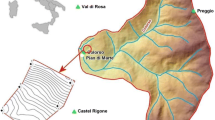Abstract
Spatial interpolation methods are normally used to create aerial rainfall maps from remote measuring data collected by raingauge network. However, most spatial interpolation methods are not in the form of interpretable data models. This could make further analysis on the spatial data difficult. This paper proposes a methodology to analyze and establish an interpretable fuzzy model for monthly rainfall spatial interpolation. The proposed methodology integrates the benefits of various soft computing techniques. The final outcome is the proposal of an interpretable fuzzy model that allows human analysts to gain insight into the spatial data to be modeled. The accuracy of the model is evaluated by eight monthly rainfall data in the northeast region of Thailand. The interpretability of the model is assessed by the interpretable fuzzy modeling criteria. The experimental results showed that the proposed methodology could be an alternative technique to create rainfall maps and to understand the characteristics of the spatial data.








Similar content being viewed by others
References
Chang T (2006) Introduction to geographic information systems, 3rd edn. McGraw-Hill, Singapore
Cordón O, Herrera F, Villar P (2001) Generating the knowledge base of a fuzzy rule-based system by the genetic learning of the data base. IEEE Trans Fuzzy Syst 9(4):667–674
Goovaerts P (2000) Geostatistical approaches for incorporating elevation into the spatial interpolation of rainfall. J Hydrol 228:113–129
Gilardi N, Bengio S (2000) Local machine learning models for spatial data analysis. J Geogr Inform Decis Anal 4(1):11–28
Hameed IA (2011) Using Gaussian membership functions for improving the reliability and robustness of students’ evaluation systems. Exp Syst Appl l38:7135–7142
Hu G, Zhang, Q (2008) Application of adaptive variable structure of ANN to distributed rainfall interpolation. In: Proceedings of IEEE Pacific-Asia workshop on computational intelligence and industrial application, pp 598–601
Ishibuchi H, Nozaki K, Yamamoto N, Tanaka H (1994) Construction of fuzzy classification systems with rectangular fuzzy rules using genetic algorithms. Fuzzy Set Syst 65:237–253
Kajornrit J, Wong KW, Fung CC (2011) Estimation of missing rainfall data in northeast region of Thailand using spatial interpolation methods. AJIIPS 13(1):21–30
Kajornrit J, Wong KW, Fung CC (2013a) An integrated intelligent technique for monthly rainfall spatial interpolation in the northeast region of Thailand. Lect Notes Comput Sci 8227:384–391
Kajornrit J, Wong KW (2013b) Cluster validation methods for localization of spatial rainfall data in the northeast region of Thailand. In: Proceedings of 12th international conference on machine learning and cybernetics
Lee S, Cho S, Wong PM (1998) Rainfall prediction using artificial neural networks. J Geogr Inform Decis Anal 2(2):233–242
Li J, Heap AD (2011) A review of comparative studies of spatial interpolation methods in environmental sciences: performance and impact factors. Ecol Inform 6:228–241
Li J, Heap AD, Potter A, Daniell JJ (2011) Application of machine learning methods to spatial interpolation of environmental variables. Environ Model Softw 26:1647–1659
Li J, Heap AD (2014) Spatial interpolation methods applied in the environmental sciences: a review. Environ Model Softw 53:173–189
Lin G, Chen L (2004) A spatial interpolation method based on radial basis function networks incorporating a semivariogram model. J Hydrol 288:288–298
Luo W, Taylor MC, Parkerl SR (2008) A comparison of spatial interpolation methods to estimate continuous wind speed surfaces using irregularly distributed data from England and Wales. Int J Climatol 28:947–959
Luo X, Xu Y, Shi Y (2011) Comparision of interpolation methods for spatial precipitation under diverse orographic effects. In: Proceedings of 19th international conference on geoinformatics, pp 1–5
Mamdani EH, Assilian S (1975) An experiment in linguistic synthesis with fuzzy logic controller. Int J Man Mach Stud 7(1):1–13
Piazza AD, Conti FL, Noto LV, Viola F, Loggia GL (2011) Comparative analysis of different techniques for spatial interpolation of rainfall data to create a serially complete monthly time series of precipitation for Sicily, Italy. Int J Appl Earth Obs 13:396–408
Sugeno M, Yasukawa T (1993) A fuzzy logic-based approach to qualitative modeling. IEEE Trans Fuzzy Syst 1(1):7–31
Tutmez B, Tercan AE, Kaymak U (2007) Fuzzy modeling for reserve estimation based on spatial variability. Math Geol 39(1):87–111
Tutmez B, Hatipoglu Z (2010) Comparing two data driven interpolation methods for modeling nitrate distribution in aquifer. Ecol Inform 5:311–315
Wong KW, Kóczy LT, Gedeon TD, Chong A, Tikk D (2001) Improvement of the cluster searching algorithm in Sugeno and Yasukawa’s qualitative modeling approach. Lect Notes Comput Sci 2206:536–549
Wong KW, Wong PM, Gedeon TD, Fung CC (2003) Rainfall prediction model using soft computing technique. Soft Comput 7(6):434–438
Zhang Q, Wang C (2008) Integrated application of artificial neural network and genetic algorithm to the spatial interpolation of rainfall. In: Proceedings of 4th international conference on natural computation, pp 516–520
Zhou S, Gan JQ (2008) Low level interpretability and high level interpretability: a unified view of data-driven interpretable fuzzy system modeling. Fuzzy Set Syst 159:3091–3131
Author information
Authors and Affiliations
Corresponding author
Additional information
Communicated by Y.-S. Ong.
Rights and permissions
About this article
Cite this article
Kajornrit, J., Wong, K.W. & Fung, C.C. An interpretable fuzzy monthly rainfall spatial interpolation system for the construction of aerial rainfall maps. Soft Comput 20, 4631–4643 (2016). https://doi.org/10.1007/s00500-014-1456-9
Published:
Issue Date:
DOI: https://doi.org/10.1007/s00500-014-1456-9




